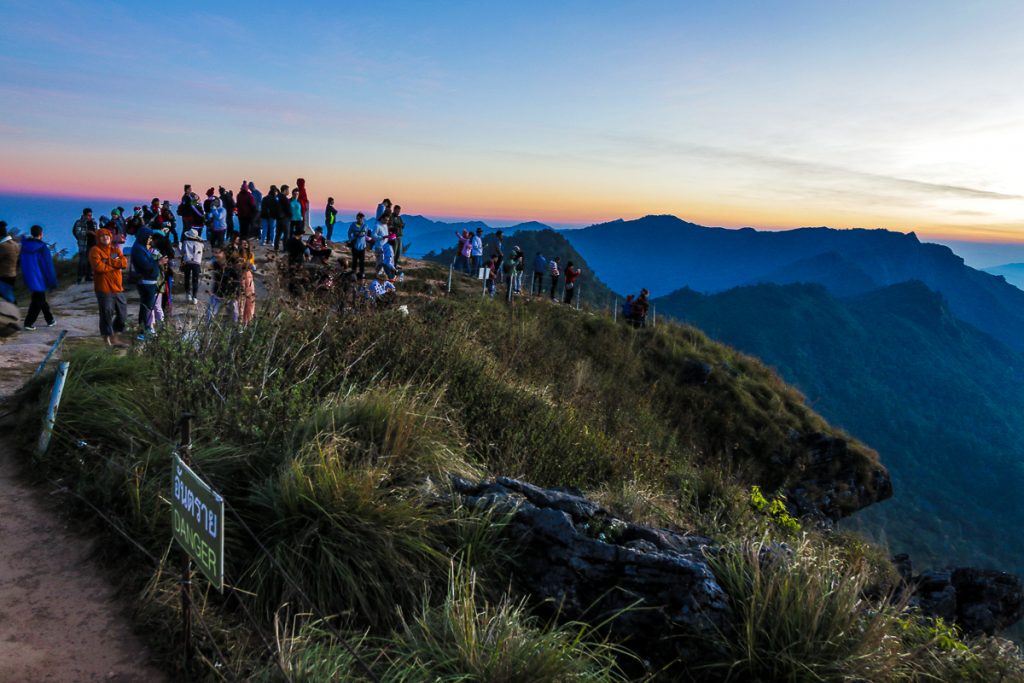It is dark, cold and we are stumbling up a rough mountain goat track at 5 am to try to get a memorable image of sunrise over Laos. Sometimes I wonder about the sanity of travel writers!
But let me start at the beginning. We are in far northern Thailand experiencing the attractions of Chiang Rai Province far from the crowds of Bangkok and Phuket. We spent the night in the border town of Mae Sai where the constant traffic between Thailand and Myanmar creates a booming economy. Thais come here to cross the border on shopping expeditions for cheap Myanmar and Chinese goods but there is limited appeal for foreigners.
The Golden Triangle

Fifty years ago, this was almost a no-go zone as it was controlled by various gangs who turned it into one of the world’s most prolific opium producing areas. Today it is cultivating tourists rather than opium. Its peaceful, untouched landscape has become a draw for visitors and as we passed through vibrant green rice fields and little villages with their golden temples, I understood its appeal.
As we headed southeast, we moved from the plains into rolling hill country and before long we reached the Hall of Opium.
I believe this is one of the best museums in Thailand outside Bangkok and almost certainly the most interesting place to visit in the Golden Triangle.
It exhibits the history of opium around the world, the production process, the devastating effects of opium smoking, and campaigns to eradicate and substitute the crop.
The Hall is something of an opium theme park, with the latest in multimedia exhibits and lots of information in a modern setting. I was impressed! It was built by the royal Doi Tung Foundation, who have been instrumental in changing the lives of the locals in a very positive way.
Where the rivers meet
The main triangle area is a few kilometres south on the Thai riverside near the point where three counties meet. You can look out and see across the Ruak River to Myanmar and across the Mekong River to Laos. This is only mildly interesting for most people, so a series of bizarre attractions have been erected by the riverside to add to the appeal.
There’s a giant golden Buddha on a ship, elephant statues which you can climb, elaborate shrines to the royal family, half a dozen signs announcing you are at the Golden Triangle, and river cruise touts, souvenir shops and various cafes. I must say I was under-whelmed and quickly realised this was a major tourist trap, so we moved on.
Chiang Saen and south

About ten kilometres downstream on the banks of the Mekong is an old Lanna capital, the small but charming Chiang Saen, which is dotted with temples, historic buildings and ruins. Wat Pa Sak was built by King Saen Phu in 1295 when three hundred teak trees were planted here. The temple’s chedi is beautiful in the Chiang Saen-style and the exteriors are elaborately decorated with designs.
Wat Phra That Chedi Luang was built by King Saen Phu, the 3rd ruler of the Lanna kingdom in the early 13th century. The bell-shaped, Lanna-style principal chedi, measuring 88 m in height, is the largest structure in Chiang Saen.
Phu Chi Fah

For the next few hours, we more or less followed the Mekong River downstream but this is not a river drive because you need to pass through some rugged mountains with plenty of winding, steep parts of the road. Little villages dot the hills and corn fields and other crops abound.
Finally, we reached our accommodation in Phu Chi Fah at the Phu Mok Dok Mai Resort which had bungalows with a small bedroom, a private bathroom, and a balcony.
The reason for visiting Phu Chi Fah is to watch the sun rise over the hills in Laos from the top of a mountain range in Thailand. If you are lucky, mists blanket the mountains below, revealing only the jungle-covered peaks in Laos. This is a magical sight.
After settling into the resort, we checked out the town. It was tiny and late afternoon most of the vendors had packed up their stalls so we decided to drive through the Phu Chi Fa Forest Park to the car park to watch the sunset. An hour later we drove down again and enjoyed dinner at the resort.
Sunrise
We were told by the locals that to watch the sunrise transform the skies from dark blue to a pinky-orange, we would need to get to the top of the Phu Chi Fa Forest Park trail way before the actual sunrise.
So, there we were climbing the 760-metre rough dirt path in the dark. We were certainly not the only ones. Flickering lights from mobile phones and torches dotted the hillside.
It was cold at the top with a stiff breeze making it uncomfortable so we were pleased when the first signs of dawn appeared. Slowly the view opened up, revealing forests, hills, valleys, farmland and the mighty Mekong River. Above it all, golden rays turned the sky into a wonderful work of abstract art.
Phu Chi Fah is not only great at sunrise and sunset though; the daytime views are also pretty spectacular. To see the snaking valleys and the rows of endless pristine mountains in Laos makes many visitors stop and contemplate their lives. It could well be Thailand’s greatest view.
How to get there
When the travel situation returns to ‘normal’ there will be flights to Bangkok from many cities around the world. From Bangkok there are many daily flights to Chiang Rai which take about 1 hour 15 minutes.
Most visitors are permitted to stay in Thailand for up to 30 days if entering via an international airport under the Visa Exemption Rule.
Images: Phensri Rutledge
Len is the author of Experience Thailand 2020 available as an e-book or paperback from https://www.amazon.com/Experience-Thailand-2020-Guides-Book-ebook/dp/B082WZZ19G/
www.LenRutledge.comhttps://www.youtube.com/channel/UCX5HUmGP1lR2aoscn3O8P2Q


















